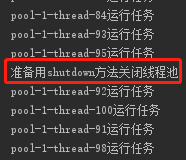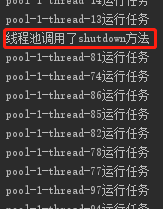演示shutdown效果的示例代码:
import java.util.concurrent.ExecutorService;
import java.util.concurrent.Executors;
import java.util.concurrent.TimeUnit;
public class Shutdown{
//由于只是为了测试下效果,所以随便搞个线程池来搭配,生产建议手动创建线程池
static ExecutorService executorService = Executors.newCachedThreadPool();
static class Task implements Runnable {
@Override
public void run() {
try {
TimeUnit.SECONDS.sleep(1);
} catch (InterruptedException e) {
e.printStackTrace();
}
System.out.println(Thread.currentThread().getName() + "运行任务");
}
}
public static void main(String[] args) throws Exception {
for (int i = 0; i < 100; i++) {
executorService.execute(new Task());
}
//加几个睡眠时间,方便看到效果
TimeUnit.SECONDS.sleep(1);
System.out.println("准备用shutdown方法关闭线程池");
executorService.shutdownNow();
System.out.println("线程池调用了shutdown方法");
TimeUnit.SECONDS.sleep(1);
System.out.println("继续向线程池提交一个任务");
executorService.execute(new Task());
}
}
运行结果:
-
准备调用shutdown方法关闭线程池

-
调用了shutdown方法后,发现之前提交的任务还是会被执行

-
但是提交新的任务就会被拒绝

演示shutdown效果的示例代码:
import java.util.concurrent.ExecutorService;
import java.util.concurrent.Executors;
import java.util.concurrent.TimeUnit;
public class ShutdownNow{
//由于只是为了测试下效果,所以随便搞个线程池来搭配,生产建议手动创建线程池
static ExecutorService executorService = Executors.newCachedThreadPool();
static class Task implements Runnable {
@Override
public void run() {
try {
TimeUnit.SECONDS.sleep(1);
} catch (InterruptedException e) {
e.printStackTrace();
}
System.out.println(Thread.currentThread().getName() + "运行任务");
}
}
public static void main(String[] args) throws Exception {
for (int i = 0; i < 100; i++) {
executorService.execute(new Task());
}
TimeUnit.SECONDS.sleep(1);
System.out.println("准备用shutdown方法关闭线程池");
executorService.shutdownNow();
System.out.println("线程池调用了shutdown方法");
TimeUnit.SECONDS.sleep(1);
System.out.println("继续向线程池提交一个任务");
executorService.execute(new Task());
}
}
运行结果:
- 通过下面一张图就能够清晰的知道,在线程池调用了shutdownNow方法后,之前提交待运行的任务不会再执行,新任务提交也一样会被拒绝。

总结
线程池调用了shutdown方法,只是拒绝新任务的提交,那些已经存放在等待队列待执行的任务一样会被执行,而shutdownNow方法则不同,一旦调用后,线程池就立即关闭了,等待队列的任务不会再被执行,新任务的提交也会被拒绝。

